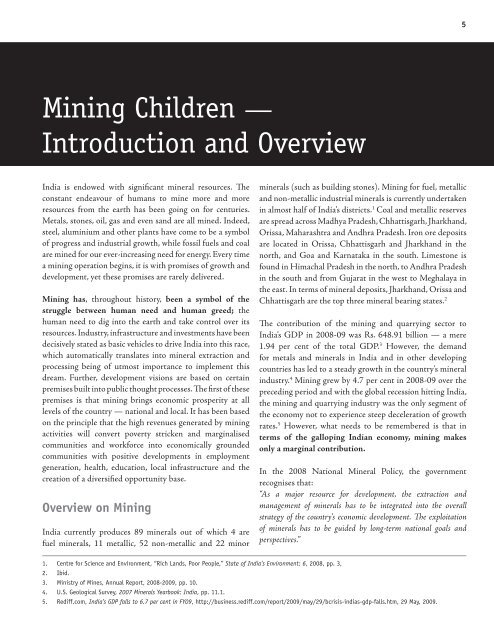Children - Terre des Hommes
Children - Terre des Hommes
Children - Terre des Hommes
You also want an ePaper? Increase the reach of your titles
YUMPU automatically turns print PDFs into web optimized ePapers that Google loves.
5<br />
Mining <strong>Children</strong> —<br />
Introduction and Overview<br />
India is endowed with significant mineral resources. The<br />
constant endeavour of humans to mine more and more<br />
resources from the earth has been going on for centuries.<br />
Metals, stones, oil, gas and even sand are all mined. Indeed,<br />
steel, aluminium and other plants have come to be a symbol<br />
of progress and industrial growth, while fossil fuels and coal<br />
are mined for our ever-increasing need for energy. Every time<br />
a mining operation begins, it is with promises of growth and<br />
development, yet these promises are rarely delivered.<br />
Mining has, throughout history, been a symbol of the<br />
struggle between human need and human greed; the<br />
human need to dig into the earth and take control over its<br />
resources. Industry, infrastructure and investments have been<br />
decisively stated as basic vehicles to drive India into this race,<br />
which automatically translates into mineral extraction and<br />
processing being of utmost importance to implement this<br />
dream. Further, development visions are based on certain<br />
premises built into public thought processes. The first of these<br />
premises is that mining brings economic prosperity at all<br />
levels of the country — national and local. It has been based<br />
on the principle that the high revenues generated by mining<br />
activities will convert poverty stricken and marginalised<br />
communities and workforce into economically grounded<br />
communities with positive developments in employment<br />
generation, health, education, local infrastructure and the<br />
creation of a diversified opportunity base.<br />
Overview on Mining<br />
<br />
fuel minerals, 11 metallic, 52 non-metallic and 22 minor<br />
minerals (such as building stones). Mining for fuel, metallic<br />
and non-metallic industrial minerals is currently undertaken<br />
in almost half of India’s districts. 1 Coal and metallic reserves<br />
are spread across Madhya Pra<strong>des</strong>h, Chhattisgarh, Jharkhand,<br />
Orissa, Maharashtra and Andhra Pra<strong>des</strong>h. Iron ore deposits<br />
are located in Orissa, Chhattisgarh and Jharkhand in the<br />
north, and Goa and Karnataka in the south. Limestone is<br />
found in Himachal Pra<strong>des</strong>h in the north, to Andhra Pra<strong>des</strong>h<br />
in the south and from Gujarat in the west to Meghalaya in<br />
the east. In terms of mineral deposits, Jharkhand, Orissa and<br />
Chhattisgarh are the top three mineral bearing states. 2<br />
The contribution of the mining and quarrying sector to<br />
<br />
3 However, the demand<br />
for metals and minerals in India and in other developing<br />
countries has led to a steady growth in the country’s mineral<br />
industry. <br />
preceding period and with the global recession hitting India,<br />
the mining and quarrying industry was the only segment of<br />
the economy not to experience steep deceleration of growth<br />
rates. 5 However, what needs to be remembered is that in<br />
terms of the galloping Indian economy, mining makes<br />
only a marginal contribution.<br />
In the 2008 National Mineral Policy, the government<br />
recognises that:<br />
“As a major resource for development, the extraction and<br />
management of minerals has to be integrated into the overall<br />
strategy of the country’s economic development. The exploitation<br />
of minerals has to be guided by long-term national goals and<br />
perspectives.”<br />
1. Centre for Science and Environment, “Rich Lands, Poor People,” State of India’s Environment: 6, 2008, pp. 3,<br />
2.<br />
3.<br />
Ibid.<br />
Ministry of Mines, Annual Report, 2008-2009, pp. 10.<br />
4. U.S. Geological Survey, 2007 Minerals Yearbook: India, pp. 11.1.<br />
5. Rediff.com, India’s GDP falls to 6.7 per cent in FY09, http://business.rediff.com/report/2009/may/29/bcrisis-indias-gdp-falls.htm, 29 May, 2009.






